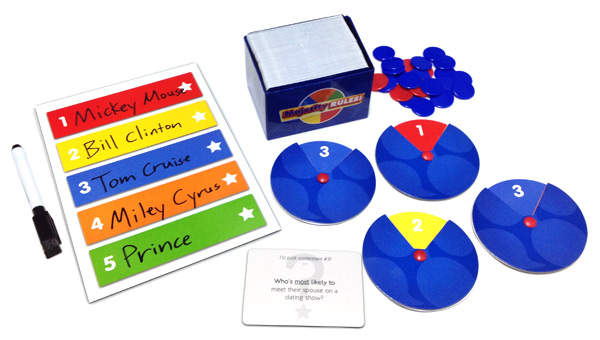Hypothetical Debates: A Review of Majority Rules

Who's most likely to lie about their age? Oprah, Justin Bieber, or your mom? It's most certainly debatable, so why not put it to a vote? That's the point of Majority Rules, a party game by FoxMind for 3 to 8 players, ages 14 and up.
Gameplay
Majority Rules consists of a ballot board, a box of question cards, several voting discs, and scoring chips. The object of the game is to score the most points, and points are scored by voting the same as the majority of players on various questions.
Before the game begins, players collectively come up with 5 people to write on the ballot board. These people can be real or fictional, contemporary or historical, a famous celebrity or a personal friend. The bigger the variety, the better. During each round, one player draws a question card and reads it aloud. The questions are similar to the "most likely" or "least likely" awards you might find in a high school yearbook. All the players then secretly vote on which of the 5 candidates they think the question applies to the most. They also bet between 1 to 3 chips that their candidate will win the majority vote.
After all votes are placed, the players reveal their votes to determine who gained the majority vote. Those who voted for the winning candidate earn as many chips as they bet, while all others surrender the chips they bet. If voting is unanimous, the vote is canceled and the bets remain for the next round. If there is a tie between two or more groups of votes, the bets for the tied candidates remain on the table and may be increased during the next round.
Play continues until one player reaches 30 points or there are no chips remaining. The player with the most points wins.

Review
Majority Rules is a simple party game that produces a lot of debating about hypothetical situations, as well as plenty of laughter — you'd better believe that when a player feels his vote is obvious yet he ends up in the minority, he will speak his mind and plead his cause. Though it won't change the outcome of the vote, it's always interesting to find out the reasoning behind the votes.
The fact that players agree on the candidates at the beginning of the game, rather than selecting them from a card, is very effective. This ensures that all of the players are familiar with the candidates and it also allows the game to become more personalized. Rather than just celebrities or famous fictional characters, anyone can be a candidate — including a family member, the girl next door, or the high school English teacher. This also means that each game will be as different as the candidates chosen by the players.
The voting and scoring mechanics of the game work well, though it is probably better for larger groups than smaller ones. The voting discs make it easy to select a candidate secretly without the hassle of writing/erasing answers (as is done in similar games). The mechanic for betting that your candidate will win the majority is a nice addition, allowing players to take risks based on their level of confidence. However, the fact that players' total scores continually fluctuate up on down based on the success or failure of their bets can theoretically cause the game to go on indefinitely (though this was not an issue in our testing).
It is important to note that this game is not family-friendly, as many of the questions may be offensive to younger or sensitive audiences. Until a family edition is produced, it is advisable to pre-screen the cards before bringing it to your next family gathering.
Overall, Majority Rules is a simple and fun game that is unique enough to stand on its own in the party game category.
Pros: Fun party game, simple to learn, lots of laughter and debates, player selection of candidates adds replay value
Cons: Not family-friendly, game could theoretically continue indefinitely
Disclosure: we received a complimentary review copy of this game.







